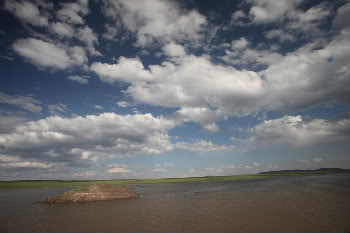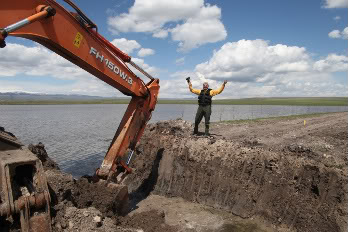|
|
A dirt road that had bisected Lake Kuyucuk in Turkey’s Kars Province has been turned into an island for birds to breed safely away from livestock, foxes, and humans. Converted from a road into island in only two months, the 200 meter-long artificial island is the first of its kind in Eastern Anatolia.
“In time, we expect to have a robust waterbird colony, hopefully reminiscent of the breeding colony of Manyas Bird Paradise in western Turkey. The island and its birds will attract more nature tourists and will increase local income at Kuyucuk, Duraklı and Carcıoğlu villages around the lake,” said Dr. Çağan Şekercioğlu, Stanford University conservation ecologist and president of KuzeyDoğa Society which oversaw many of the aspects of the project.
 The 200 meter-long island will provide critical habitat for nesting birds. Photo courtesy of Şekercioğlu. |
The island’s creation also restored the lake to its natural state by reconnecting the southern and northern section, which the road had bisected. On May 13th the road officially became an island; four days later construction was completed. The speed and inexpensive nature of the artificial island could be a model for future conservation projects.
The island’s construction was based on ecological principles and contemporary bird island construction methodology. Its construction was overseen by Şekercioğlu, the KuzeyDoğa Society team, and wetland restoration expert Dr. Sean Anderson of California State University Channel Islands.
The lake had already been established as a protected area after a request from the Kars Directorate of Environment and Forestry and KuzeyDoğa Society to Turkey’s Wetland Commission. Conservation zones were delineated by the Wetland Commission, the KuzeyDoğa Society, and local villagers in October 2008. It was during this meeting that KuzeyDoğa Society proposed that the dirt road be turned into an island to serve breeding birds.
“We have so far recorded 206 species of birds at Kuyucuk, sometimes exceeding 40,000 individuals at once. The reedbeds that provide shelter and nesting areas for birds have been destroyed due to overgrazing at Lake Kuyucuk, which we estimate to host more than half the 465 species of birds found in Turkey,” said Şekercioğlu.
 From dirt road to island. Photo courtesy of Şekercioğlu. |
The island was created by removing fifty meters from both ends of the dirt road. This excavated soil was then added to the southern bank of the newly-created island, creating a gradual slope whose shallow bank will allow more bird species to breed on the island. Ninety-three trees comprised of local species were planted on the island’s northern side. Plans are in place to erect nesting platforms on the island to attract cormorants and herons, which do not nest on the ground. The island is inaccessible to many of the local threats to birds including people, cattle, sheep, horses, foxes, wolves, dogs and cats.
“More than 5,500 cattle and sheep graze around this shoreline. Foxes comprise another threat to breeding birds. This island will provide a haven from human and cattle disturbance and from fox predation. Bird numbers should increase as a result of higher breeding success on the island,” Şekercioğlu said.
Local officials and conservationists believe the island will attract tourism, including both local and international birders, to the area.
“Besides providing a haven for breeding birds, this island will promote Kars and Lake Kuyucuk throughout Turkey and the world,” Şekercioğlu said. “We hope it will also contribute to the local economy by increasing nature tourism. This island, the most recent culmination of our ecological restoration work at Lake Kuyucuk, should also inspire other nature protection and ecological restoration projects in Turkey.”
Şekercioğlu adds that the island could not have been created without the unflinching support of Kars governor Mehmet Ufuk Erden: “his personal enthusiasm, vision and commitment to nature protection were the biggest factors for successfully realizing this historic first. Constructing an island for birds is the best demonstration of the environmental sensibility here in landlocked Kars.”
Spelling out the importance of the island Şekercioğlu says that “this island will make Lake Kuyucuk a true bird paradise and will promote Kars as an example of nature conservation and nature tourism.”
An interview with Dr. Cagan Şekercioğlu: http://news.mongabay.com/2008/0714-cagan_interview.html
Related articles
Updated Red-List: 192 birds are Critically-Endangered
(05/14/2009) In this year’s updated IUCN Red List on birds, six species were down-listed from Critically Endangered to Endangered, but eight species were up-listed to Critically Endangered, leading to the highest number of Critically Endangered birds ever on the list. In all 1,227 bird species (12 percent) are currently considered threatened with global extinction.
Bird migrations lengthen due to global warming, threatening species
(04/15/2009) Global warming is likely to increase the length of bird migrations, some of which already extend thousands of miles. The increased distance could imperil certain species, as it would require more energy reserves than may be available. The new study, published in the Journal of Biogeography, studied the migration patterns of European Sylvia warblers from Africa to breeding grounds in Europe every spring. They discovered that climate change would likely push the breeding ranges of birds north, causing migrations to lengthen, in some cases by a total of 250 miles.
Birds face higher risk of extinction than conventionally thought
(07/14/2008) Birds may face higher risk of extinction than conventionally thought, says a bird ecology and conservation expert from Stanford University. Dr. Cagan H. Sekercioglu, a senior research scientist at Stanford and head of the world’s largest tropical bird radio tracking project, estimates that 15 percent of world’s 10,000 bird species will go extinct or be committed to extinction by 2100 if necessary conservation measures are not taken. While birds are one of the least threatened of any major group of organisms, Sekercioglu believes that worst-case climate change, habitat loss, and other factors could conspire to double this proportion by the end of the century. As dire as this sounds, Sekercioglu says that many threatened birds are rarer than we think and nearly 80 percent of land birds predicted to go extinct from climate change are not currently considered threatened with extinction, suggesting that species loss may be far worse than previously imagined. At particular risk are marine species and specialists in mountain habitats.